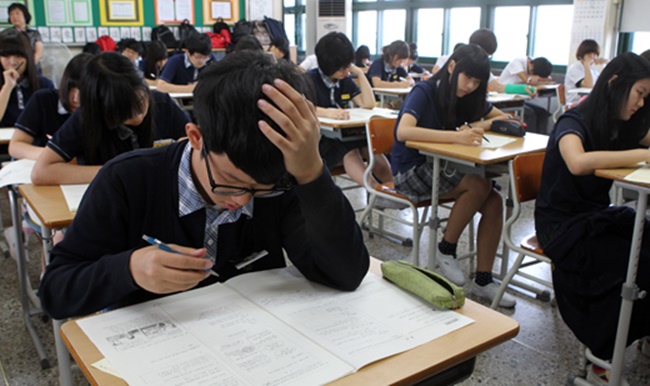
South Korean teenagers are less satisfied with their lives compared to their peers in other developed nations. (Image courtesy of Yonhap)
SEOUL, Jul. 5 (Korea Bizwire) – A new report has revealed that South Korean teenagers are less satisfied with their lives compared to their peers in other developed nations, highlighting concerns about youth well-being in a country known for its high-pressure education system.
According to the “2024 Key Statistics in Child-Related Fields” study released by the National Center for the Rights of the Child on July 4, only 26.1% of 15-year-olds in South Korea reported high levels of life satisfaction. This figure is 7.7 percentage points below the average of 33.8% among countries in the Organization for Economic Cooperation and Development (OECD).
The OECD study, conducted in 2022, asked 15-year-olds to rate their life satisfaction on a scale of 1 to 10. Those who scored between 8 and 10 were considered to have “high life satisfaction,” while scores of 4 or below indicated “low life satisfaction.”
Conversely, 22.3% of South Korean teens reported low life satisfaction, exceeding the OECD average of 17.9% by 4.4 percentage points.
The report also sheds light on the primary concerns of South Korean youth. A separate survey by Statistics Korea in 2022 found that academic performance topped the list of worries for teenagers aged 13 to 18. An overwhelming 76.2% of respondents cited studying, grades, or aptitude as their main source of anxiety.
Other significant concerns included physical appearance (42.8%), career choices (36.2%), and relationships with friends (35.8%). Notably, 27.2% of teens reported struggling with physical or mental health issues.
The pressure extends beyond academics, with one in four teenagers experiencing stress in their home and school lives. According to the Statistics Korea survey, 23.7% of respondents reported feeling stress at home, with an additional 2.1% describing their stress levels as severe.
In the school environment, stress levels were even higher, affecting 25.6% of elementary and middle school students and 29.3% of high school students.
The comprehensive report covers nine key areas, including child population statistics, social policies and infrastructure, rights, health, learning and development, care environments, leisure activities, safety and violence, and relationships and subjective well-being. It compiles data from various sources, including OECD and Statistics Korea indicators.
Chung Ick-joong, the director of the National Center for the Rights of the Child, emphasized the importance of the report in understanding the quality of life for South Korean children. “We hope this report will serve as a valuable resource for promoting the healthy growth and rights of children,” Chung said.
The full statistical report is available on the National Center for the Rights of the Child’s website.
M. H. Lee (mhlee@koreabizwire.com)






